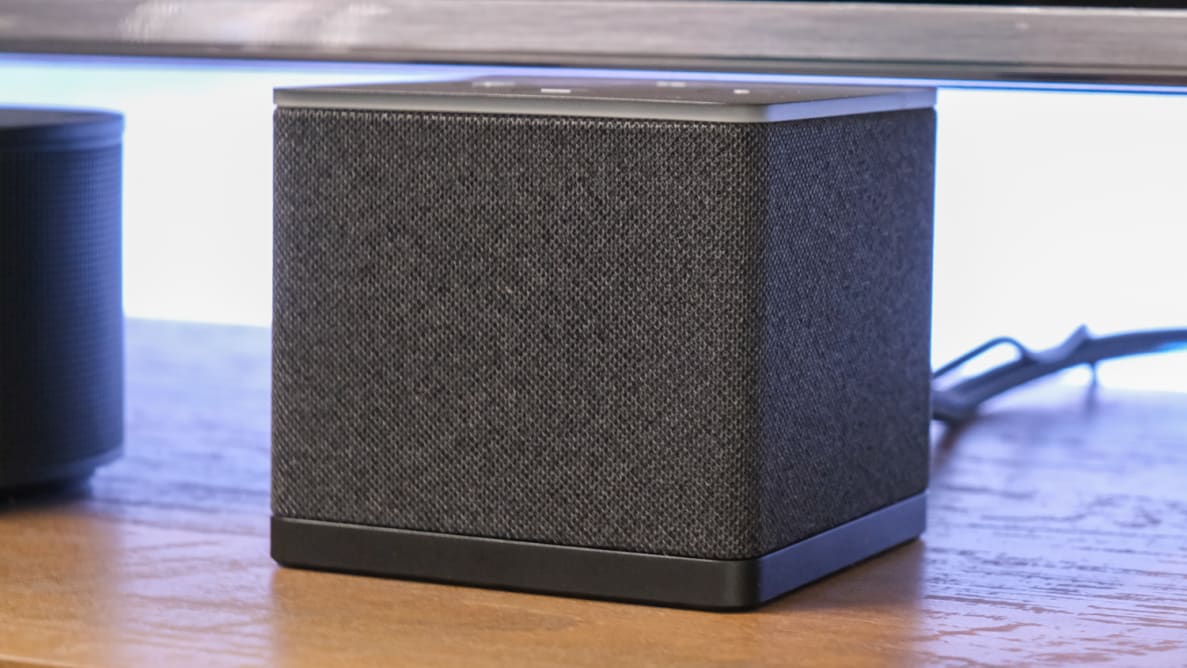Pros
-
More approachable design
-
HDMI input
-
Fire OS works well for Amazon fans
Cons
-
Limited remote functionality
-
Built-in speaker is only for Alexa
For the new third generation, Amazon takes things a step further. The Amazon Fire TV Cube (3rd Gen) subtly adds an HDMI input, meaning you don’t necessarily have to switch inputs on your TV to use other devices. Who says Amazon ever has to be uninvolved?
About the Amazon Fire TV Cube (3rd Gen)
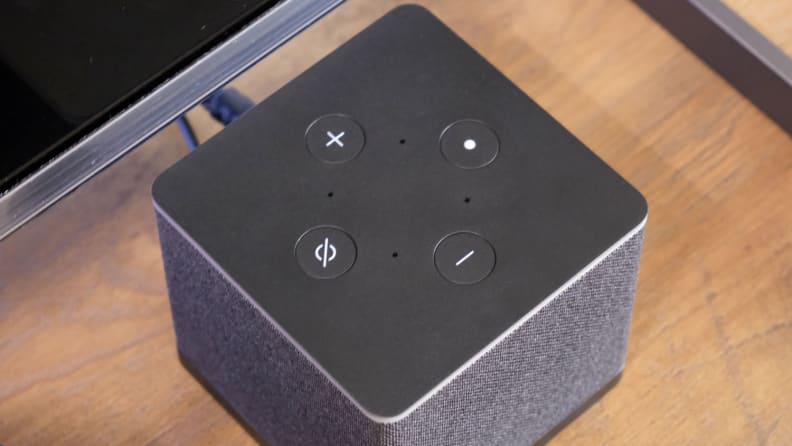
On the top of the Fire TV Cube are volume controls, an Alexa microphone mute button, and the select button.
- Resolution: 4K at 6Hz
- HDR: Dolby Vision, HDR 10, HDR10+, HLG
- Ports: HDMI 2.1 (In and Out), IR Extender, Power, USB-A, Ethernet port
- Networking: Wi-Fi 6E and 802.11a/b/g/n/ac/ax
- Processor: Octa-core
- Audio: Dolby Atmos, Dolby Digital Plus
- Remote: Alexa remote with software controls and Prime Video, Netflix, Disney+, and Hulu buttons
- Smart Assistants: Alexa
- Video Codecs: H.265, H.264, VP9, AV1
- Audio Codecs: AAC-LC, AC3, eAC3 (Dolby Digital Plus), FLAC, MP3, PCM/Wave, Vorbis, Dolby Atmos (EC3_JOC), Dolby MAT
- Storage: 16GB
- RAM: 2GB
- Dimensions: 3.38 x 3.38 x 2.99 in (W x D x H)
- Weight: 1.13lb
The Amazon Fire TV Cube really only comes in one variant. There are no color options, no storage options, and really no other options at all—a Fire TV Cube is a Fire TV Cube. You’ll get the Fire TV Cube, a voice remote, and a power cable in the box. There’s no external IR blaster included in the box, despite the fact that the Fire TV Cube supports one—so you’ll need to buy one separately, if necessary.
The Fire TV Cube has a speaker built into it, however, that speaker is really there as a way to use the Cube as an Alexa speaker when the TV isn’t on. You can’t play your TV’s audio through the speaker (not that you would want to, given the audio quality), and when you ask Alexa to play music, the device will actually turn on your TV to do so. Some will find that annoying, but the point is that Amazon does not want to emphasize the Fire TV Cube as a speaker first.
What we like
Solid design
The general look of the Amazon Fire TV Cube is similar to the previous generation, but with some changes that make it look closer to other Amazon products, and to help make it a little more approachable in your living room.
How so? Well, the biggest change is that the front sides now have a similar textile covering as the Echo and Echo Dot, which I much prefer to the boring black plastic of previous generations, and the corners have been rounded out a little, again, helping make the design a little less harsh. The top edge still has a light bar to indicate Alexa, which is always handy.
On the top, is the same four-button setup with volume buttons, a microphone mute button, and an Action button. On the back are the ports, which we’ll get into in the next section.
The Amazon Fire TV Cube now looks more refined and more approachable. It looks that extra bit better in most living rooms.
Upgraded port selection
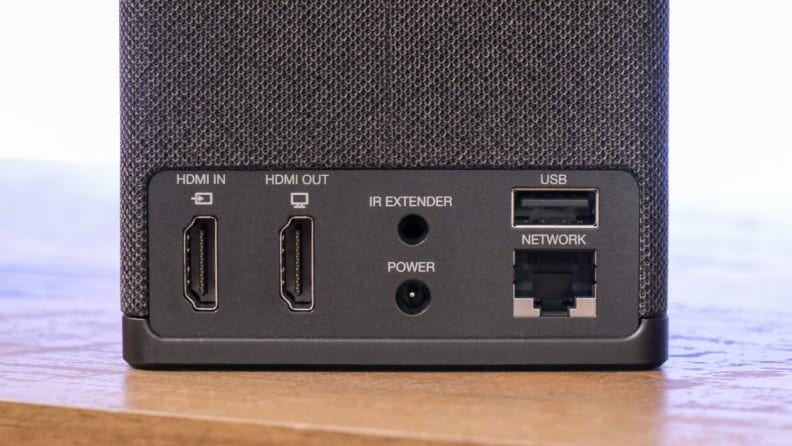
The 3rd gen Fire TV Cube comes with more connections than its predecessor, including an HDMI input.
We kind of skipped over the ports in the last section, but that’s because the ports warrant their own section.
Some of the ports are the same as before, but others are upgraded or replaced with better options. For starters, there are separate USB and Ethernet ports instead of a basic MicroUSB port. That means that you don’t have to rely on adapters for things like expanding storage and adding a wired internet connection.
Perhaps even more important is the fact that the Fire TV Cube offers an HDMI input on top of the HDMI output. That turns the Fire TV Cube into a small hub, meaning only one HDMI cable runs to the TV. You can connect a cable box, game console, or anything else to the HDMI input, then use the Fire TV Cube remote or Alexa to switch between the Fire TV interface and whatever is connected to the HDMI input. When using the input, you’ll still be able to use Alexa and get an Alexa overlay, if that’s something you care about. The Fire TV Cube learns what kind of device is connected, and uses the 360-degree infrared blaster to control that device.
The input and output are both HDMI 2.1, however they do not support passthrough at 120Hz, so they won’t necessarily work great with the Xbox Series X and PlayStation 5. If a high refresh rate, and a variable refresh rate, are important to you, you’ll want to stick with connecting your console directly to your TV, assuming it supports a high refresh rate and VRR.
I would have liked to see Amazon fully embrace this concept, though—which would mean having at least three or four HDMI inputs. Maybe one day the Fire TV Cube will truly act as an AV receiver, but that would necessitate expanded audio support, too. HDMI passthrough as a concept has had its ups and downs, and while it’s neat in this instance, it will be interesting to see if enough customers embrace it enough for it to last the test of time.
Fire OS works well
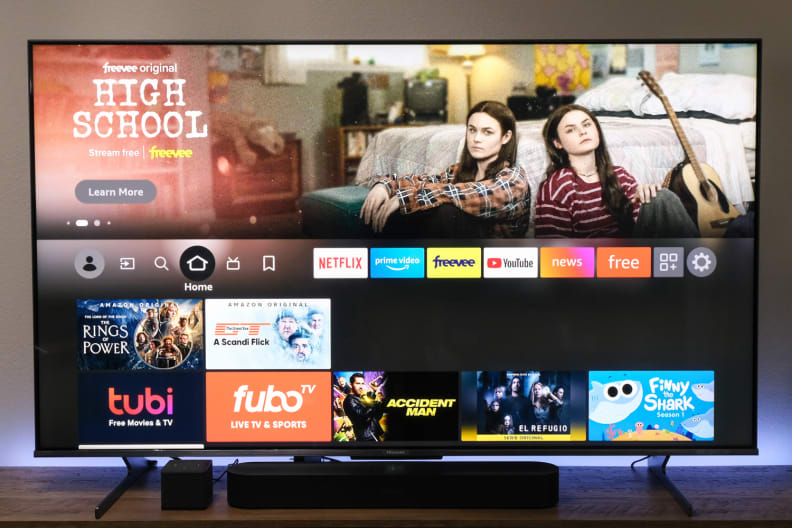
The Fire TV Cube does a great job running Amazon's Fire OS.
While Amazon’s Fire OS operating system isn’t what I use on a day-to-day basis, I still generally like it, and on the Fire TV Cube, it works quite well.
The interface is relatively easy to navigate. It’s split up into rows of content, with a row of apps at the top. It definitely prioritizes Prime content over anything else, but you’ll still see recommended content from your other apps throughout the interface.
On the Fire TV Cube, it runs pretty well too. Amazon has included a new processor in the device that it says gives the Cube two times better performance than the Amazon Fire TV Stick 4K Max. It’s a little hard to quantify that, but overall, the interface ran smoothly and never stuttered or skipped.
The interface also has a new gaming interface, which allows you to access games from Luna, Amazon’s game-streaming service, and games to play on your connected gaming console. Amazon says you’ll also be able to see content from other game-streaming services. I use Xbox Game Pass, however, and that app is not currently available on Fire OS. As game streaming becomes more popular, I expect that all services will be available on all devices, like video streaming services are now. That may take a few years though.
Super Resolution Upscaling
Amazon is touting the new Super Resolution Upscaling feature as a great way to make HD content look like 4K content. The device is able to upscale both contents played through the installed apps and from sources connected to the HDMI input. That’s particularly helpful for those whose cable boxes max out at 1080p (at best).
Generally, it looks pretty good. As is normally the case with upscaling tech, it doesn’t look quite as natural as native 4K content, but it gets pretty darn close. The result is image quality that you might forget isn’t 4K in day-to-day use. The Fire TV Cube does better upscaling 1080p than it does 720p content. 1080p content looked pretty good, but while 720p content still looked great compared to the original video, it did look notably worse than content in 1080p.
What we don’t like
Doesn’t come with fancy new remote
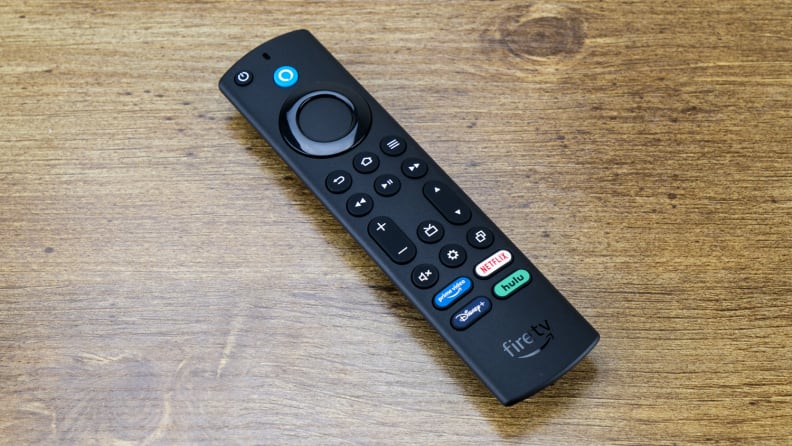
The included remote is pretty basic and not the new Alexa Voice Remote Pro.
The Amazon Fire TV Cube comes with an upgraded remote that includes channel up and down buttons to control channels through infrared on a connected cable box. It’s a solid remote, but if this is Amazon’s top-of-the-line streaming device, it should come with its top-of-the-line remote, the Alexa Voice Remote Pro.
Notably, the included remote doesn’t have Amazon’s new Remote Finder feature, nor does it have customizable buttons or the headphone button to quickly pair to Bluetooth headphones. These aren’t deal-breakers, but it is annoying to see Amazon skimp. The remote does still offer everything you need to control software, and use Alexa, and it has quick access controls for Prime Video, Netflix, Disney+, and Hulu, which is nice.
Speaker is only fine
Amazon isn’t billing the Fire TV Cube as a replacement for your TV’s existing sound system. In fact, you couldn’t use it as one even if you wanted to—and you wouldn’t want to. The Fire TV Cube is fine for Alexa, but the overall speaker quality doesn’t lend itself well to much more. Even if you try to play music on the Fire TV Cube, it will turn your TV on to do so and instead play through your TV speakers or connected sound system.
Limited smart features compared to new Echo devices
One of the coolest new features on the Echo Dot is the fact that it can act as an Eero Wi-Fi extender. That’s one of the advantages of the Amazon ecosystem. But you would expect new features to come to all new devices, and that isn’t the case here. Unfortunately, you can’t use the Fire TV Cube as an Eero range extender.
Should you buy it?
Yes, if you’re embedded in Amazon’s ecosystem
The question about which device of any kind to get increasingly comes down to the ecosystem. If you’re in Apple’s ecosystem, the best smartwatch is an Apple Watch. If you’re in Google’s you want a Google Nest Audio smart speaker. And if you’re in Amazon’s, you want a streaming device with Fire OS. The Amazon Fire TV Cube is the best streaming device with Fire OS.
There are some caveats to that. If your TV already has Fire OS built into it, you shouldn’t get a Fire TV Cube just for the smart speaker feature—get an Echo Dot instead and save the cash. If you don’t care about the smart speaker component or more advanced features like the HDMI input, a Fire Stick 4K is the way to go.
But if you want the best that Fire TV has to offer, including a built-in smart speaker, inputs, and fast processing, the Fire TV Cube is the way to go.
Meet the tester
Christian de Looper is a consumer tech journalist with over a decade of experience. De Looper has covered all areas of the consumer tech industry, from smartphones to smart homes — and has attended all of the major trade shows, including CES. De Looper has always been interested in consumer technology, but his love for gadgets and electronics blossomed into a full-blown passion when he started writing about it while completing his degree in audio production. Since then, he has written for many of the top tech publications, including [Digital Trends](https://www.digitaltrends.com/users/delooper/), [Tom’s Guide](https://www.tomsguide.com/author/christian-de-looper), [TechRadar](https://www.techradar.com/author/christian-de-looper), and many more. He loves getting his hands on all of the latest gadgets, but when he’s not reviewing tech, he can be found hanging out with his family or producing music.
Checking our work.
Our team is here to help you buy the best stuff and love what you own. Our writers, editors, and experts obsess over the products we cover to make sure you're confident and satisfied. Have a different opinion about something we recommend? Email us and we'll compare notes.
Shoot us an email